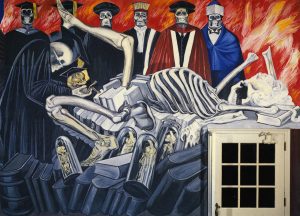The Gods of the Modern World
José Clemente Orozco
In 1932, José Clemente Orozco, a Mexican muralist, came to Dartmouth College. He began The Epic of American Civilization in the basement of the Baker library and completed it in 1934; however, specific analysis will be placed on the panel Gods of the Modern World due to interest in its extremely controversial criticism of institutionalized education.
In the foreground, one can see stacks of grey books dispersed among glass bell jars that are filled with fetal skeletons wearing mortarboard hats. In the middle ground of work, there lies a skeleton on top of a pile of books. This skeleton appears to have a head of white hair giving it a feminine appearance. She sits in a birthing position with her legs splayed, arms in the air, and a stomach pregnant with books. Placed between her legs is the skeleton of a full-grown man wearing a mortarboard hat and a graduation gown. Hunched between the legs of the female skeleton, he cradles her skeleton fetus. In the background, there are six, adult-male skeletons who are all also wearing academic regalia. Flames and intense shades of red cover the top and background of the panel. The imagery of skeletons and red flames can invoke macabre connotations of death, hell, and stagnation.
This panel is titled Gods of the Modern World. This title suggests that modern society has made the institution and its members into deities. In relation to the rest of the mural, this panel parallels the panel titled Gods of the Ancient World that depicts the god Quetzalcoatl and a pantheon of other Gods from pre-Columbian Mesoamerica.
The figure of the female skeleton is placed in the center of the painting and is not sized proportionately to the other skeletons. Through her slack jaw and unnaturally positioned arms and legs, Orozco depicts her intense distress. One of her arms is even broken, expressing violence and isolation. The other six academics are staring forebodingly at the female skeleton, with detached and unsympathetic expressions, playing to the deadness of their skeleton figures.
The role of color serves to distinguish the fore and middle ground from the background. The color scheme in the foreground and middle ground follows a gradient of gray, white, and black, with hints of crème to emphasize the color of dead bone. This gradient furthers the theme of death and stagnancy within the institutionalized education system. The background skeletons have white and crème colored bones and wear black-colored graduation robes with deep red and blue accents. The variety of robe and academic regalia can be interpreted to represent the various degrees of higher-level education, and the placement of the “watchers” above the birth of the fetal skeleton emphasizes their superiority. In the back of the panel, red hues give the impression of flames and illustrate the ideas of war, imperialism, and capitalist wealth of the previous panel.
This piece is also referred to as Still-Born Education[1], demonstrating that the perpetuators of education are skeletons, and they breed to deliver an education that is dead, reflecting the ideas of the classic, dead, and western philosophers that provide a sterile and abstract education[2]. It is said that Orozco believed that despite the supposed freedom in the United States, people are led to be subservient and not question authority[3]. The gateway to this pathway was education, as clearly reflected in this panel.
This panel may also reflect the history of education. The arrival of the missionaries in the Americas led to the first forms of education in western and Anglo-Saxon academia. These missionaries caused not only the physical death of many indigenous populations but also the death of their own education and belief systems.
The birthing and presence of the fetal skeleton with the mortarboard hats can represent a variety of things. The fetal skeletons can represent the new generation to be educated, who will end up following the paths of the dead education system. The fetal skeletons can also represent education itself, illustrating that emerging scholars and publishing will endure the same future as their predecessors because they are bred by the same classic literature (represented by the skeleton pregnant with books). The fetal skeletons in the bell jars appear to be preserved, which represents how education is being frozen in time, stagnated to follow certain ideals set out by the institution.
This stance on institutionalized education caused much conflict at the college because it appeared that Orozco was insulting the very foundations of higher education at an Ivy League college. Nevertheless, years of analysis of the stories and ideals of Orozco have revealed the mural to be a priceless piece of art as well as history.
[1] Harding, Erin C. “Orozco at Dartmouth.” Etchings.com. N.p., 1997. Web. 13 Jan. 2017.
[2] Harding, Erin C. “Orozco at Dartmouth.” Etchings.com. N.p., 1997. Web. 13 Jan. 2017.
[3] Harding, Erin C. “Orozco at Dartmouth.” Etchings.com. N.p., 1997. Web. 13 Jan. 2017.

